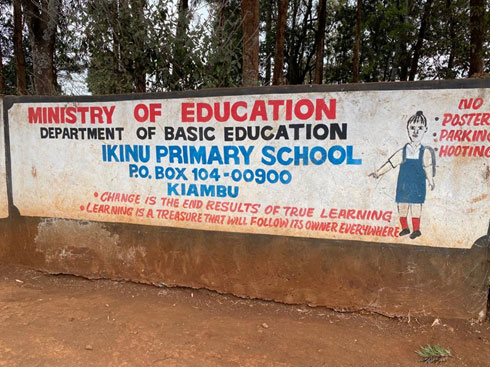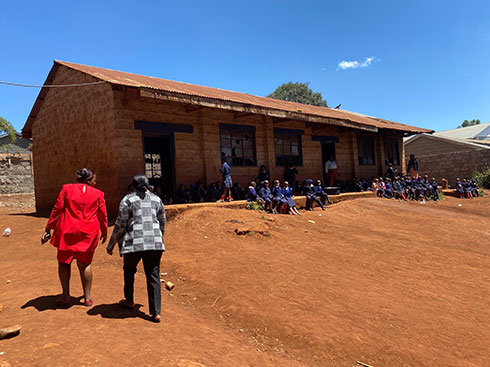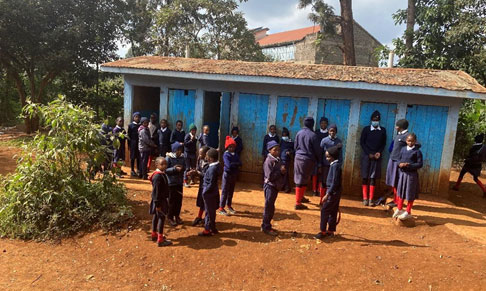Case Study
WASH4Schools applied its approach to school sanitation to Ikinu Primary School in Githunguri, Kiambu County, Kenya
WASH4Schools applied its approach to school sanitation to Ikinu Primary School in Githunguri, Kiambu County, Kenya
| Type of Project | Semi-rural school sanitation pilot and demonstration project |
|---|---|
| Project Period | November 2022 to December 2022 with continuous monitoring through 2023 |
| Project Scale | Provide proper sanitation for at least 1400 learners using 16 pit latrine cubicles daily, completely overwhelming the existing facilities |
| Total Investment | USD 30,000 (10 new toilet cubicles connected to a biogas system to be utilized in a school feeding programme and rehabilitation of the existing pit latrines to improved water-based state) |
| Address of the project location | Ikinu Primary School, Githunguri in Kiambu County, Kenya |
| Planning organisation | Toilets for All, Mobile Alert Toilets and Sanevi |
| Executing organisation | Mobile Alert Toilets, Sanevi, Sistema.bio and Aljuli Engineering Ltd |
| Supporting Agency | Toilets for All Foundation and Ikinu Primary School Board of Management (BOM) |
The school circular sanitation project had the following objectives:


The majority of Kenya schools either totally lack or have dilapidated sanitation and hand-washing facilities. Schools are often unable to provide a healthy environment mostly due to the lack of political motivation and attention to sanitation and hygiene.
This generally leads to:
Ikinu Primary School is a mixed school with a student population of 1400 learners located in Githunguri, a semi-rural town in Kiambu County, Kenya. The main occupations in the area are small-scale trades and agriculture.
The school currently has a set of 3 pits latrines with 34 doors: 16 for girls, 10 for boys, 6 for children under 3, and 2 urinals for boys but all of them are in deplorable conditions. The facilities cannot serve the large student population adequately. Long queues are common especially for girls who do not have the option of urinals like boys.
Over time, the strain and pressure has taken its toll on the toilets making them unsafe and undignified. Some lack doors or have caving walls and leaky roofs.

The project’s rationale was to construct an additional 10-cubicle latrine for the school to reduce pressure on the existing facilities and allow learners to spend the least amount of time at the toilets to allow a timely return to class.
The old broken-down units were renovated to complement the newly built sanitation blocks. Part of the renovations included modification of the latrines to allow for periodic flushing of feces to promote overall toilet hygiene.
The focus of the sanitation facilities was to use the excreta in the production of biogas to support the existing school feeding programme. A complete biogas system (2 reactors and post-treatment works) was included in the civil works of this project directly linked to the sanitation facilities.

The toilets built under this program mainly served as an entry point for promotion and creating awareness. To this end, 15 handwashing stations were provided to ensure the promotion of hygiene after toilet use. Further, 10 urinals were also provided to complement toilet use in this case by the boys only. To provide balance, girls were instead allocated more toilet cubicles to use than boys. The school administration, the board of management (BOM, and the surrounding community were involved to ensure the success of the project objectives. These groups committed efforts as well as fiscal and temporal resources to support project implementation.
Training and establishment of the blue school
As observed in our previous school projects in Kenyan schools, hygiene education is practically non-existent. All students, teachers and parents at Ikunu Primary School were asked to participated in training with the objective of creating awareness for sustainable operations and maintenance of school toilets, and linking between sanitation, hygiene and health.
Additionally, learners were encouraged to form a blue school to promote improved sanitation practices through circular economy approaches. Training on MHM was also conducted for the girls population including insights on proper disposal of the materials after use to prevent any cases of blockages of the new toilet system installed.
Costs and economics
The investment costs for the new 10 toilet cubicles were KES. 1,000,000 (approximately CHF. 10,000) as shown in the table below.
| Item Category | Cost in KES | Cost in CHF |
|---|---|---|
| 10 toilet cubicles | 1,000,000 | 10,000 |
| 2 biogas reactors | 700,000 | 7,000 |
| 1 Water tank for flushing | ||
| 10 Urinals units | ||
| 15 Handwashing units | ||
| Doors | ||
| Painting job | ||
| Roofing | ||
| Etc. |
Operation and maintenance
Through the school BOM, Ikinu Primary School made a commitment to cover operations and maintenance (O&M) costs for the facilities and the biogas system. Since the school is a public institution, the available private financing options, often in the form of debt, were not an option to complement any fiscal needs towards anticipated O&M. However, the BOM, through parents, committed to ensuring O&M would be taken care of adequately. The availability of cooking gas meant that the school cut costs on some of the previous existing kitchen expenses. These recouped costs were transferred to cover O&M requirements.
The major challenge in implementing sanitation facilities in schools is creating sustainable operation and maintenance systems within the schools. This strongly relates to the level of ownership. Since the participation, the financial and material contribution of the schools and surrounding community was considerably high, the ownership sufficiently developed. This is anticipated to promote the cleaning and management of the facilities.
Lessons on Urinal-toilet ratio and our recommendations thereof….
Lessons on MHM….
Cost-Benefits lessons of the resource-oriented systems in schools….